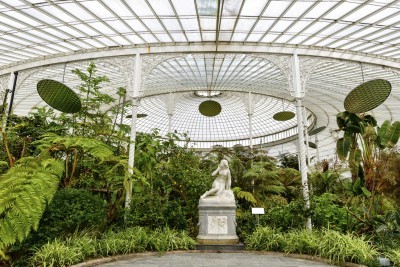






Botanical gardens are one of our most important resources for knowledge and collection of flora around the globe. What are botanical gardens? Each institution performs the functions of research, teaching and protecting important plant species. What botanical gardens do for the health of the planet and as a conservation tool is extremely important and largely unfulfilled in most other organizations. Their work is the unified effort of scientists and plant lovers as well as community based organizations and volunteerism.
Gardeners and students of plant life recognize the diverse appeal of botanical gardens. Botanical gardens are more than display areas and sites of great beauty. The McIntire Botanical Garden gives the definition as, “…a collection of living plants and trees for display, research, education, and conservation.” As such, botanical garden information encompasses learning and teaching, data gathering, study and preservation of collections from every corner of the globe.
The first understanding of botanical gardens is as a coalescence of display areas filled with plants. While this is often true, botanical gardens also utilize signs, tour guides, interactive displays and other methodology to enhance the visitors experience and convey community connections, world natural affairs and modern techniques.
These institutions are also responsible for student curriculum and outreach programs. The diverse nature of the programs offered engage the visitor and provide comprehensive tools for the understanding of plants and ecology and our role in both. Starting a botanical garden is often a local undertaking, usually under the guidance of a university or other body of learning. This allows for a holistic view of the gardens and ensures government and community participation.
What botanical gardens do is often as important a question as what they are. Botanical gardens in the western world date back to the 16th and 17th century, where they were primarily medicinal and research collections. Over the centuries they have evolved to be places of peace and fellowship combined with providing a plant sanctuary and knowledge center.
Botanical gardens partner with each other to allow for information exchange, plant propagation and sharing and participation from around the globe in garden-based activities and research. The dissemination of botanical garden information at one site can be exchanged and enhanced by partnerships with gardens in any part of the world. The exchanges lead to a better understanding of plant knowledge and the role we must play in conservation.
Three of the most profound functions of a botanical garden are to teach stewardship, educate and explain environmental ethics. These functions are the framework of the botanical garden and the guides to every other aspect of the organization.
Starting a botanical garden is an important first step to creating youth involvement in conservation and perhaps start us back on a road to respecting our world and all the life it contains.
What Are Garden Gnomes: Uses For Garden Gnomes In The Landscape
What Are Root Cuttings: Information On Taking Cuttings From Root Growth
Garden Seating Ideas: What Are The Different Types Of Garden Seating
What Is A Rockery – Information On Garden Rockery Construction
What Are Pirate Bugs: Taking Advantage Of Minute Pirate Bugs In Gardens
What Are Big Eyed Bugs: How Are Big Eyed Bugs Beneficial In Gardens
What Is A Biofungicide: Information On Using Biofungicides In Gardens
What are the Benefits of Ergonomic Garden Tools?
What Are Aerial Roots: Information About Aerial Roots On Houseplants
What Is A Hindu Garden: Tips For Creating Hindu Gardens
What Is A Reading Garden: How To Create A Reading Nook In Gardens
What Kind of Gardener Are You?
What Are Predatory Wasps: Information On Useful Wasps That Are Predatory
Copyright © www.100flowers.win Botanic Garden All Rights Reserved